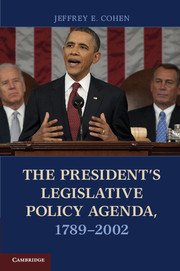Book contents
- Frontmatter
- Contents
- List of Figures
- List of Tables
- Introduction
- Chapter 1 The President's Legislative Policy Agenda
- Chapter 2 Studying Agenda Building
- Chapter 3 A Theory of Presidential Agenda Building and the Congressional Response
- Chapter 4 The Size of the President's Agenda, 1789–2002
- Chapter 5 The Substantive Content of Presidential Agendas
- Chapter 6 Divided Government and Presidential Policy Moderation
- Chapter 7 From the White House to Capitol Hill
- Chapter 8 Conclusion
- Bibliography
- Index
Chapter 1 - The President's Legislative Policy Agenda
Published online by Cambridge University Press: 05 November 2012
- Frontmatter
- Contents
- List of Figures
- List of Tables
- Introduction
- Chapter 1 The President's Legislative Policy Agenda
- Chapter 2 Studying Agenda Building
- Chapter 3 A Theory of Presidential Agenda Building and the Congressional Response
- Chapter 4 The Size of the President's Agenda, 1789–2002
- Chapter 5 The Substantive Content of Presidential Agendas
- Chapter 6 Divided Government and Presidential Policy Moderation
- Chapter 7 From the White House to Capitol Hill
- Chapter 8 Conclusion
- Bibliography
- Index
Summary
He shall from time to time give to the Congress information of the state of the union, and recommend to their consideration such measures as he shall judge necessary and expedient. (United States Constitution, Article II, Section 3)
Article II, Section 3 of the Constitution, quoted here, had among the most profound implications for the presidency of any words written in the Constitution. That passage planted the seeds for two presidential institutions, the State of the Union Address (SUA) and the president's legislative policy agenda, the latter becoming the legislative program in 1946. These institutions breached the strict wall of separation between the president and Congress and transformed the president into an important policy leader and participant in the legislative policy-making process.
Perhaps only the presidential inauguration can rival the SUA as a high-state ceremonial occasion. George Washington complied with the constitutional requirement for a “state of the union” message to Congress less than a year after taking office, on January 8, 1790. The 1091-word document congratulated Congress on its legislative actions of the previous year and informed Congress on the general health of the economy. The document, however, also raised the specter of foreign policy problems and the need for the nation to prepare for hostilities with several Indian tribes.
- Type
- Chapter
- Information
- The President's Legislative Policy Agenda, 1789–2002 , pp. 13 - 33Publisher: Cambridge University PressPrint publication year: 2012

